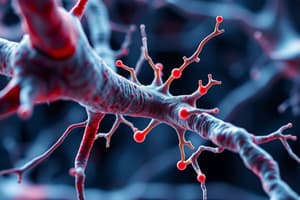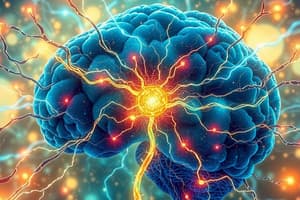Podcast
Questions and Answers
Why is acquiring a new language generally easier for children than for adults?
Why is acquiring a new language generally easier for children than for adults?
- Adults have already filled their memory capacity with other information.
- Children's brains are smaller, allowing for quicker information processing.
- Adult brains have a reduced capacity for forming new neural connections compared to children. (correct)
- Children are less self-conscious about making mistakes.
Which of the following best describes how phantom limb sensation demonstrates neuroplasticity?
Which of the following best describes how phantom limb sensation demonstrates neuroplasticity?
- Amputation causes new neural pathways to form, enhancing other senses.
- The brain creates illusions to cope with the trauma of limb loss.
- The brain’s ability to generate new limbs to replace those that are lost.
- The sensory cortex reorganizes, causing sensations from one body part to be perceived in the missing limb. (correct)
What factor most significantly influences the magnitude of neuroplastic changes in the brain?
What factor most significantly influences the magnitude of neuroplastic changes in the brain?
- The level of physical fitness.
- The amount of sleep one gets.
- The age of the individual.
- The quantity of activity and stimulation the brain receives. (correct)
Which of the following situations exemplifies maladaptive plasticity?
Which of the following situations exemplifies maladaptive plasticity?
What is the primary role of neuroplasticity in normal brain development?
What is the primary role of neuroplasticity in normal brain development?
Which of the following best describes the role of neurotransmitters in neuronal communication?
Which of the following best describes the role of neurotransmitters in neuronal communication?
What is the underlying principle of neuroplasticity, often summarized as 'use it or lose it'?
What is the underlying principle of neuroplasticity, often summarized as 'use it or lose it'?
How do short-term changes in synaptic strength typically occur?
How do short-term changes in synaptic strength typically occur?
What structural changes are associated with long-term memory retention?
What structural changes are associated with long-term memory retention?
How might significant and sustained activity impact cortical areas in the brain?
How might significant and sustained activity impact cortical areas in the brain?
What is a functional change in neurons as it relates to neuroplasticity?
What is a functional change in neurons as it relates to neuroplasticity?
How can healthy brain tissue facilitate recovery following a stroke?
How can healthy brain tissue facilitate recovery following a stroke?
Which mechanism underlies the behavioral changes induced by stimuli such as stress or physical exercise?
Which mechanism underlies the behavioral changes induced by stimuli such as stress or physical exercise?
Flashcards
Phantom Limb Sensation
Phantom Limb Sensation
The sensation that an amputated limb is still present.
Neuroplasticity
Neuroplasticity
The brain's ability to reorganize itself by forming new neural connections throughout life.
Somatosensory Cortex Reorganization
Somatosensory Cortex Reorganization
Sensory inputs from one area of the body affect the perception of another area due to cortical reorganization.
Childhood Brain Plasticity
Childhood Brain Plasticity
Signup and view all the flashcards
Impact of Activity on Brain Plasticity
Impact of Activity on Brain Plasticity
Signup and view all the flashcards
Neurons
Neurons
Signup and view all the flashcards
Synapse
Synapse
Signup and view all the flashcards
Neurotransmitters
Neurotransmitters
Signup and view all the flashcards
"Use it or lose it" Principle
"Use it or lose it" Principle
Signup and view all the flashcards
Short-term memory (neuroplasticity)
Short-term memory (neuroplasticity)
Signup and view all the flashcards
Long-term memory (neuroplasticity)
Long-term memory (neuroplasticity)
Signup and view all the flashcards
Functional Neuroplasticity
Functional Neuroplasticity
Signup and view all the flashcards
Study Notes
- Neuroplasticity refers to the brain's ability to change and reorganize itself throughout a person's life.
- It underlies learning and the brain's ability to repair itself after injury.
- The brain is composed of billions of neurons that communicate through synapses, the spaces between them.
- Neurotransmitters facilitate communication between neurons by transmitting chemical messages across synapses.
- A typical neuron can form thousands of synaptic connections with other neurons, creating intricate networks responsible for various brain functions.
- Synaptic connections and neurons can change over time through neuroplasticity.
- Neuroplasticity is activity-driven, following the "use it or lose it" principle: frequently used synapses strengthen, while rarely used ones weaken or are eliminated.
- New activities stimulate the creation of new neural connections.
Synaptic Strength
- Changes in synaptic strength can be short-term or long-lasting, depending on the intensity and frequency of the signal received.
- Neurons can temporarily strengthen connections by releasing more neurotransmitters, activating new receptors, or modifying existing receptors.
- This is the basis of short-term memory.
- Long-term memory retention needs strong or sustained activity, which will result in structural changes, such as growing new dendritic spines and synaptic connections, or even forming new neurons.
- Structural neuroplasticity can enlarge cortical areas associated with increased activity and shrink areas with less activity.
- An example is that the hand motor region on the left side of the brain is larger in right-handed individuals.
Functional Neuroplasticity and Injury
- Neurons can adopt new functions when sufficiently stimulated.
- Healthy brain tissue can take over functions of damaged areas after a stroke.
- Stress or physical exercise can cause neurons to switch neurotransmitters, often converting them from excitatory to inhibitory or vice versa, leading to behavioral changes.
Phantom Limb Sensation
- Patients who have lost a limb through amputation may still experience sensations from the missing limb. This is called phantom limb sensation.
- Sensory signals from the face may spill over to the inactive arm region in the somatosensory cortex.
- The brain's higher centers misinterpret this as sensation coming from the absent arm.
Neuroplasticity and Age
- Brain plasticity is more pronounced in children because their brains are still developing.
- This is essential for normal brain development, creating functional brain circuits, and learning.
- Acquiring new skills, like languages or musical instruments, is easier in childhood.
- Negative or maladaptive changes due to neuroplasticity can have long-lasting consequences, especially if they occur during childhood - childhood traumas.
Brain Health
- The magnitude of neuroplastic changes depends on the amount of activity the brain receives.
- More practice leads to more learning and keeping the brain active is important for maintaining its health and effectiveness.
Studying That Suits You
Use AI to generate personalized quizzes and flashcards to suit your learning preferences.
Description
Neuroplasticity is the brain's ability to reorganize itself by forming new neural connections. Synaptic connections and neurons can change over time. This process is activity-driven, and follows the "use it or lose it" principle.




